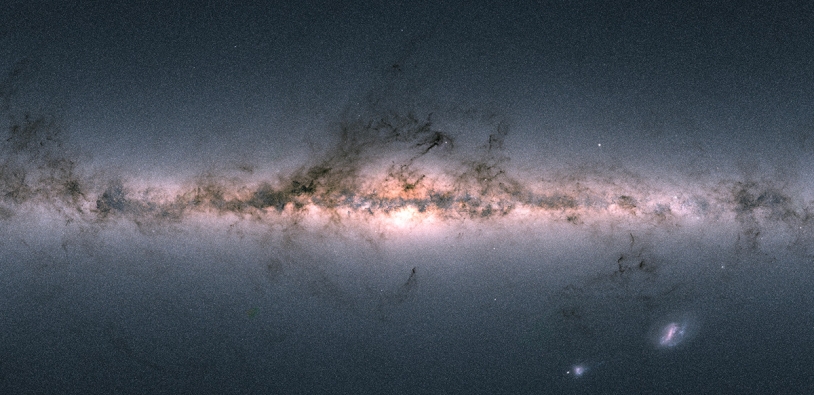Ever more objects
While previous releases have enabled scientists to classify an impressive number of stars in our galaxy, documenting their positions, velocities, brightness and colours, the Gaia DR3 catalogue adds a host of new parameters and takes the number of recorded objects to 1,811,709,771. Among these new parameters are stars’ rotational velocity, mass, age and metallicity (abundance of heavy atoms).
Besides the stars in our Milky Way, the mind-boggling amounts of data accumulated since Gaia began observing in 2014 have enabled other stellar objects to be recorded:
- Quasars: very distant active young galaxies
- Solar system objects: new asteroids and moons
- Binary star systems: stars that live together, unlike our solitary Sun
- Distant galaxies: vast clusters of stars bound together by gravity : de vastes amas d’étoiles liées par la gravité.
Gaia serving science
The science value of Gaia DR3 is considerable, giving new scientific communities interested in quasars or small objects in the solar system access to a treasure trove of new data.
And that is exactly the spirit of the Gaia mission: to provide ultra-precise data on our galaxy to help astronomers and astrophysicists delve deeper to understand where we came from to know where we’re going.
Three major discoveries to emerge from this latest data release are:
- The age of the Milky Way has been pinned down much more precisely than previous estimates: its formation is now thought to have started 0.8 billion years after the Big Bang (estimated at 13.8 billion years ago).
- The primitive galaxies from which our Milky Way formed have been identified.
- Gravitational lenses, a kind of mirage first predicted by Einstein and increasingly talked about in recent years, have been observed by Gaia., ces mirages prédits par Einstein et dont on entend parler de plus en plus ces dernières années, ont été observées par Gaia.
Detail of image opposite, from top: map of radial velocities of objects in our galaxy (darker objects are approaching us and lighter objects moving away); map of radial velocities and proper motions of objects in our galaxy; map of interstellar dust concentrated in the galactic disc; map of chemical elements making up our galaxy.
You asked for DR3… well here it is
To produce Gaia DR3, our engineers and technicians have drawn on the expertise acquired from processing Gaia data since 2013, backed up by CNES’s supercomputers. This latest release of the Gaia catalogue is the culmination of a painstaking effort 80% led by CNES teams.
Four representations of our Milky Way galaxy generated from the new data in the Gaia DR3 catalogue. Credits: ESA.

A great accomplishment for CNES
“We’re all extremely proud to have worked on creating and editing this Gaia star catalogue,” notes Chantal Panem, Gaia mission and operations manager at CNES (pictured).
Within the Data Processing & Analysis Consortium (DPAC) of 430 European scientists, engineers and technicians, the 25 men and women at CNES’s Data Processing Centre were involved in the colossal data processing effort. The team is in charge of designing, developing and validating the algorithms that serve to process Gaia data. Their role is to make the raw data collected by Gaia talk and render them readily usable. For this task, engineers and technicians are able to draw on more than 15 years of astrometry expertise acquired from the Hipparcos mission and a titanic coding effort.
In 2010, CNES entered the big data era with its bold decision to leverage the technologies of the Web giants to efficiently sift through the huge amounts of data. This third Gaia catalogue embodies the determination, team spirit and pride of CNES, French research laboratories and service providers contributing to the mission. And there’s no let-up for CNES’s teams, since we’re already working on processing Gaia data for the fourth release planned in 2025 and the fifth in 2030.

Gaia at a glance
The Gaia mission led by the European Space Agency (ESA) aims to map our near-galactic environment as precisely as possible by collecting astrometry, photometry and spectroscopy data. Sent into space in 2013 by a Soyuz launcher from our spaceport in Kourou, French Guiana, the Gaia satellite is today the cornerstone of efforts to understand our Milky Way. It has reached this enviable position as a result of eight years gathering data from its orbit around the L2 Lagrange point, sitting ‘behind’ Earth and beyond the Moon’s orbit. All these data are recorded in a catalogue, which takes the form of a massive online database, since if we had to print it on paper it would be 180 kilometres thick.
Links

